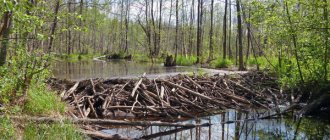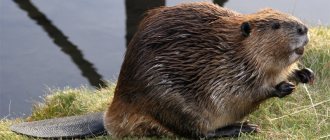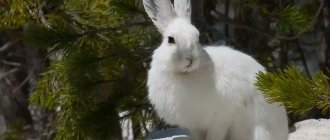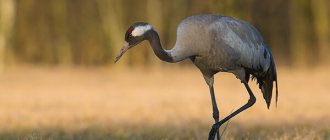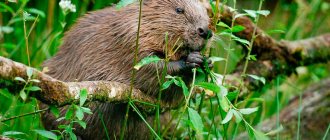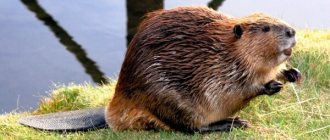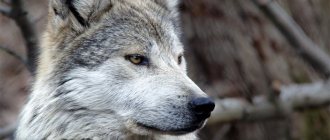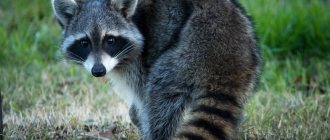Differences between Canadian and common beavers
Both representatives of the species are very similar in appearance, although the Eurasian one is larger in size. It has a larger and less round head, while the muzzle is shorter. Also, the tail is narrower and the undercoat is smaller. In addition, the Eurasian has shorter limbs, therefore, it does not move well on its hind legs.
Almost 70% of common beavers have brown or light brown fur, 20% have chestnut fur, 8% have dark brown fur, and just 4% have black fur. Half of Canadian beavers have a light brown skin tone, 25% have a brown tint and 5% have a black tint.
The common beaver has much longer nasal bones and the nostrils are triangular in shape, while the Canadian beaver has triangular openings. Europeans have larger anal glands. In addition, there are differences in the color of the fur.
After repeated attempts to crossbreed an American male and a Eurasian female, the females either did not become pregnant at all or gave birth to dead cubs. Most likely, interspecific reproduction is impossible. There is not only a territorial barrier between these populations, but also a difference in DNA.
In addition to external differences, these two representatives of this family have differences in the number of chromosomes. Thus, Canadian beavers have forty chromosomes, while ordinary beavers have 48. The different number of chromosomes is the reason for the unsuccessful crossing of these representatives of different continents.
Another difference between beavers can be considered a disaster: the Canadian beaver does not build dams, it creates huge dams compared to the buildings of its brother from Europe. Such structures can stretch for several hundred meters in length. Since today the Canadian beaver actively populates regions in Russia, their structures radically change the ecology. As a result, dams in the surrounding area cause floods, and what’s interesting is that the less rugged the terrain they inhabit, the larger their zone of influence! They change the fullness of rivers with all the ensuing environmental problems. In addition, Canadian vandals “mow down” the nearby forests, which form the coastlines and, in general, are the most important environmental factor. In addition, beavers from nearby state farms and farms steal crops, and also commit outrages there in every possible way.
Natural enemies
The Canadian beaver has few enemies: it is always vigilant and, sensing danger, manages to enter the water. Young and sick animals are in a more vulnerable position and are attacked by forest predators:
- bears (black and brown);
- lynx;
- wolves;
- wolverines;
- coyotes;
- otters;
- martens.
The main destroyer of the beaver, which is stably sedentary and trusting of baits, is considered to be man . A fatal role in the fate of the Canadian beaver was played by its amazing fur, which, with special dressing, turned into felt from beaver hair.
It was from this that long-lasting headdresses were sewn, including the famous Napoleonic cocked hats, elegant ladies' hats and prim top hats. Beaver hats, as an unconditional ancestral value, were passed down from father to son.
This is interesting ! Rodents have been hunted since the Middle Ages, which ended in the almost complete destruction of river beavers by the 17th century. The Russian population also suffered, which is why our country lost the title of the world fur capital.
It is unknown what animal the “orphaned” European goldfinches would have switched to if not for rumors about North American beavers. Thousands of free hunters and huge fleets went to distant Canada: already in the mid-19th century, 0.5 million beaver pelts were sold at fur auctions in Edinburgh and London.
By the way, New Amsterdam, later renamed New York, has been the center of the beaver fur trade since its founding.
Return to content
Spreading
The Canadian beaver is found in Alaska (in North America), except on the northern, northeastern and eastern coasts; In Canada; in the USA almost everywhere, except Florida, most of Nevada and California; in the northern part of Mexico. It was also brought to the countries of Scandinavia. From Finland he entered the Leningrad region and Karelia. It was introduced on Sakhalin and Kamchatka, as well as in the Amur basin.
Threats
Young beavers are very vulnerable and are threatened by bears, wolves, wolverines, lynxes, fishers and otters. The size of an adult beaver is a deterrent to most predators. And while natural predators pose a very real threat to Canadian beavers, humans have proven that they are by far the greatest threat to these rodents. Killing beavers for their pelts, habitat modification and pollution are detrimental to Canada's beaver population.
Lifestyle
His lifestyle is similar to that of the Eurasian. The Canadian beaver is also active at night, only sometimes appearing during the day and sometimes moving far from the water. Animals dive and swim remarkably well and can stay underwater for up to fifteen minutes. Beavers live in families of up to eight individuals - a parent pair and its children. Young individuals stay with their parents for up to two years. Families are always territorial and protect their areas from other animals.
The boundaries of the site are marked with a beaver stream (the secretion of the anal glands), which is applied to mounds of silt and dirt. When in danger, animals hit the water with their tails, thus giving an alarm signal. Like the Eurasians, they live in huts, which they build from brushwood smeared with earth and silt. From the huts there are passages under the water; in them the floor is covered with bark, wood shavings and grass. The Canadian beaver settles in burrows much less frequently than its Eurasian counterpart. To regulate the flow speed and water level, he builds dams on rivers from branches, logs, silt, stones, and clay. Canadians have excellent construction skills.
Dam construction
The famous beaver structure is the dam.
Why do beavers build dams? So that they have more water. Quite often, a family of beavers settles on a small river or stream in order to raise the water level in them, rodents and erect these grandiose structures. Thanks to the dam, the river turns into a small lake, which is a favorite habitat for beavers.
Reproduction
Typically, beavers live in families consisting of a female and a male, as well as young animals of the previous and current year. The breeding season in most places is January-February. The offspring of the previous year, who are about two years old at this time, are expelled from the colony to search for shelter elsewhere, as well as for their mate.
The gestation period is 107 days, and the male and his children temporarily move into a special burrow until the birth of the offspring between April and June. The act of birth takes several days, usually up to 5 beaver cubs are born. The babies are completely pubescent, their incisors are visible, and their eyes are open. Just after being born, beaver cubs can enter the water quite calmly, since they can swim from the moment they appear. The majority of adult individuals are monogamous; a couple can break up only with the death of a partner.
Description
Beavers are primarily aquatic animals and are the largest rodents on the North American continent. They have a waterproof, rich, glossy, reddish-brown or blackish-brown coat. The undercoat is much finer than the rest of the protective coat. The ears are short and round, dark brown in color. The beaver's hind legs are longer than its front legs, which makes the back of the body higher than the front when walking. Body length from 90 to 117 cm.
The beaver's skull and teeth are disproportionately large. This is very important for the ability to chew on hardwoods such as maple and oak. Most upper incisors are bright orange in color and are at least 5mm wide and 20-25mm long. These teeth grow throughout the animal's life and are essential for survival, as are closing nostrils, ears, and transparent membranes on the eyes, ideally suited for life in an aquatic environment. Beavers chew the bases of trees with their strong incisors and thereby knock them to the ground. The front paws are used for digging, carrying and placing building materials.
Also of note are the anal and fur glands found in males and females. Both sets of glands are located at the base of the tail, which is perhaps the most distinctive feature of beavers. The tail is wide, flat and covered, in large parts, with blackish scales. Its length is from 20 to 25 cm, and its width is from 13 to 15 cm. The anal glands measure 8.6 cm by 5.5 cm, and the fur glands measure 7.6 cm by 2.4 cm. The odor released from these glands is serves as a marking and is also characteristic of beavers.
Nutrition
The Canadian or North American beaver eats exclusively plant foods. These animals feed on shoots and bark of trees; they choose willow, aspen, birch and poplar. In addition, they eat all kinds of herbaceous plants (water lily, cattail, iris, reed, etc., up to three hundred items in total). A huge number of softwood trees is a necessary condition for their habitat. Linden, hazel, bird cherry, elm and other trees are of secondary importance in their diet. They do not eat oak and alder, but use it for their buildings. The daily amount of food is up to a fifth of the animal's weight. A powerful bite and large teeth enable beavers to easily cope with plant-based solid food.
In the summer, the proportion of herbaceous food in the beaver diet increases. At the same time, in the fall they prepare food for frost. They put their reserves in water, where they are able to retain their valuable nutritional qualities until February. To prevent food from freezing into the ice, beavers melt it under overhanging steep banks below the water level. So even after the reservoir freezes, food remains accessible under thick ice.
Interesting Facts
- The beaver is a natural swimmer. The animal's body is designed to remain in water for a long time. The rudder-shaped tail and webbed toes enable the beaver to swim at speeds of up to 8 km/h.
- A beaver can stay under water for about 15 minutes.
- Beavers do not hibernate.
- Beaver stream is widely used in medicine. It has strong bactericidal and healing properties.
Number
The Canadian beaver, unlike the Eurasian beaver, which was almost completely exterminated, suffered much less. It is not a protected species; its number reaches 15 million individuals, but before the colonization of North America there were tens of times more of them. These animals were intensively hunted for meat and fur, and this led to a rapid reduction in their range by the beginning of the nineteenth century. Then, thanks to restoration and conservation measures, their total number increased significantly.
Man and beaver
At the moment, the Canadian beaver in some countries is considered an extremely harmful animal, since the dams built by these animals lead to flooding of the area. Moreover, their construction activities can completely destroy vegetation along the banks. Although in general, beavers have a good impact on coastal and aquatic biotopes, while creating conditions for the flourishing of various organisms.
The beaver is the national animal of Canada. He is depicted on the 5 cent coin. In addition, it is a symbol of the states of New York and Oregon, and is also depicted on the emblems of the California and Massachusetts Institute of Technology.
Features of behavior
Beavers live in families. The maximum number of individuals related to each other by blood does not exceed 8. For the first 2 years of life, the litter lives next to its parents. During this period, young beavers acquire knowledge of dam construction. In addition, the grown-up offspring watches the newborn beavers and accepts condolences in collecting food.
Beavers defend their territory, both from predators and from other representatives of their species. Rodents mark their territory and show aggression towards strangers. Older individuals leave marks using a beaver stream. Tail slapping the water is used to warn of a potential threat.
Beavers are active in the evening; during the day, these rodents emerge from their huts only in extreme cases. Rodents may continue to leave their homes while gathering and searching for food. In the event that one of the representatives of the family finds a good akratotherm of food, the rodents begin building a channel to transport food to the hut. In order to provide food during the winter, Canadian beavers make provisions from branches and logs.
Fur coat: Canadian beaver
Such a fur coat has been valued in Rus' for a long time.
This is exceptionally fluffy, soft and very warm fur. Having a unique undercoat, it is well suited to Russian climate conditions and is able to protect against any bad weather. In terms of wearability (this is considered one of the main criteria in the hierarchy of valuable furs), such a fur coat is superior even to mink. In addition, the beaver is not afraid of moisture, and this is a huge rarity among furs. Also, under wet snow it only becomes fluffier. This fur is not the easiest to work with. Plucked fur is considered exclusive and, therefore, the most expensive. Plucking technology is a labor-intensive jewelry process that greatly increases the cost of a fur coat, while making it especially airy and light. Only whole skins of young animals are used in this work. For each product, the color scheme is selected individually. Sometimes this can take a whole year. Although the result of this is a real picture of a harmonious color scheme, shimmering with natural shades from light to dark.
Habitat
The activity of Canadian babrs manifests itself during grazing time. Rodent-like mammals feel comfortable in water and are able to completely submerge under it for 15 minutes. On land, beavers are vulnerable, which explains why they spend the maximum amount of time in the aquatic environment.
The permanent habitat of Canadian beavers is remote rivers, lakes and streams with a slow flow. Rodents can reduce the speed of the current by building dams from fallen trees. Material execution) construction animals are transported through channels of their own creation. Underwater rodents also build their homes on their own. Beavers build several types of homes:
Minks. Minks are most often created by Eurasian beavers, while Canadian beavers prefer to live in huts. Huts. Huts are floating structures made of brushwood, silt and earth. The height of an unusual building can range from 1 to 3 m, and the diameter of the hut in some cases reaches 10 meters. Beavers will chew through a series of entrances, one of which will be underwater. The dwelling has a small clearing that allows free passage of air. Beavers chew it out at the top of the house.
Rodents prepare the coffin for cold weather by covering the hut with earth. During the first frost, the globe freezes, creating strong protection from external environmental influences. Apart from that, the hut is covered with wood chips, tree bark and grass. Huts are used by beavers for rest at night and for storing supplies. Rodents hide in shelter from predatory animals.
Dams built by beavers from wood, stones of various sizes, wet soil and grass provide rodents with protection from predators. In addition, the dams are home to different species of fish, waterfowl and other animals that live in the reservoir. The structure helps reduce soil erosion and reduce the risk of flooding.
Despite all its positive properties, the dam is not a strong and permanent structure, and can only exist in beaver habitats that will maintain it in proper condition. As usual, the construction of dams begins with the approach of cold weather - in the autumn. Beavers, which live in the northern regions, can destroy buildings by females. Such actions are explained by the need to reduce the water surface in the reservoir, increase the oxygen content, or reach the trees growing behind the dam. Sometimes otters and other animals can damage the integrity of buildings.
